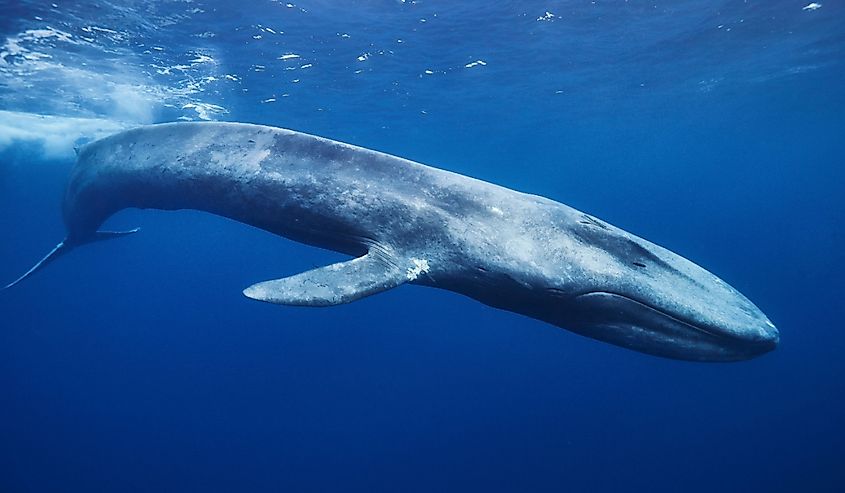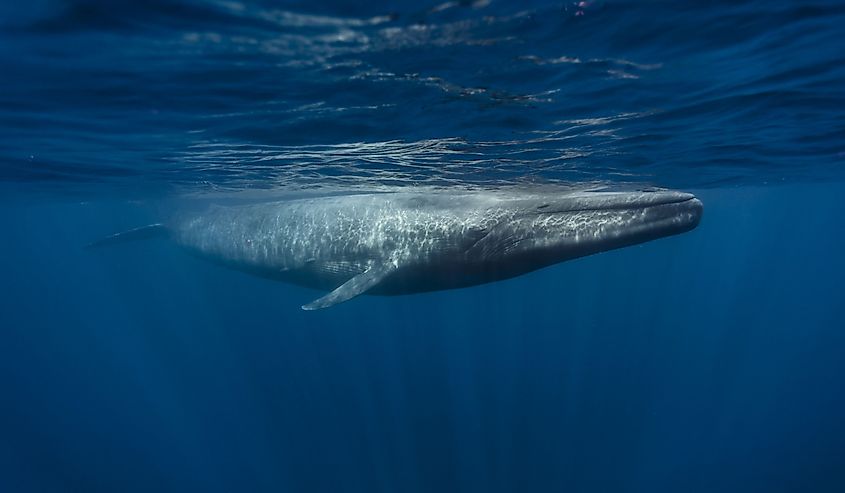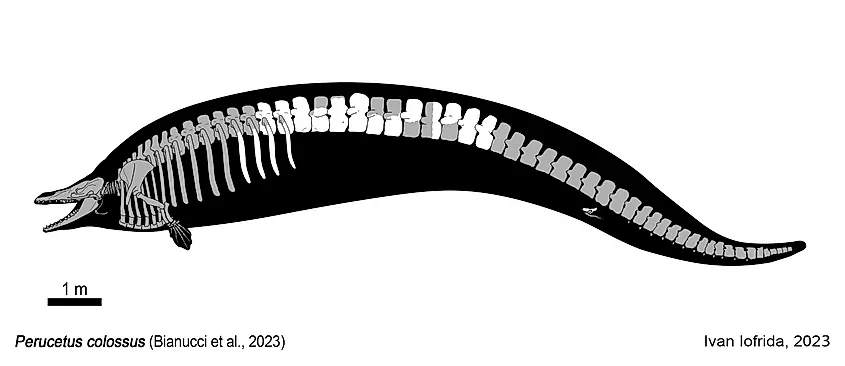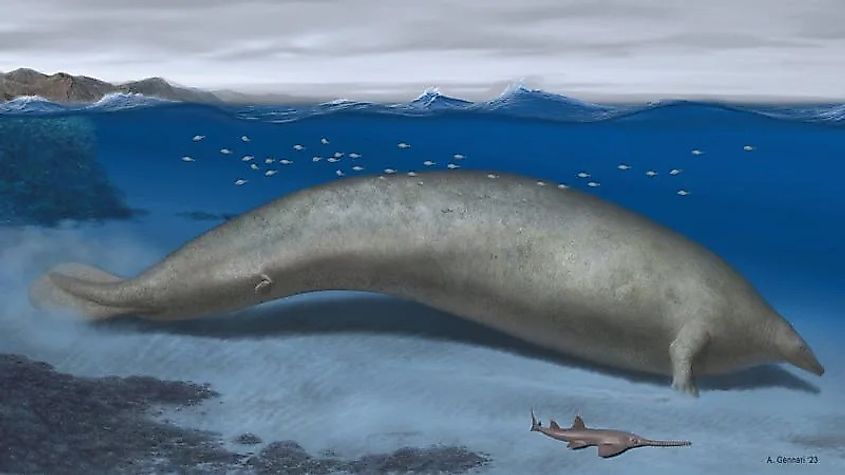
Why the Blue Whale Might Not Be the Largest Animal in History
Around 100 million years ago, during the late Cretaceous period, the breakaway continents slowly drifted toward their eventual permanent locations. South America was still attached to Africa, with Australia and Antarctica drifting southward. Humans did not exist, but if they had, they probably would not have survived long.
In the place known as Argentina today, the Andes Mountains had not yet risen. Colossal shadows appeared on the lush forest floor as Argentinosauruses, some of the largest land animals of all time, searched for the greenest leaves at the tops of towering trees. At an average of 115 feet long, the Argentinosaurus compared well to the gigantic Maraapunisaurus and Supersaurus that lived during the late Jurassic period.
If the oceans around Argentina had held blue whales at the time, these gentle giants would have surpassed the Argentinosaurus in sheer size. Traditionally believed to be the largest animal that ever lived, blue whales inhabited the world’s seas 25 million years ago, during the Oligocene epoch.
The Supersaurus was the longest dinosaur, spanning approximately 140 feet from head to tail and weighing up to 40 metric tons. The Argentinosaurus grew to 128 feet and weighed around 100 metric tons. In comparison, the blue whale grew to 100 feet but weighed 200 tons. These sizes are staggering.
The Argentinosaurus was so huge that it would have been difficult for the creature to move around. The blue whale, which still exists today, is so enormous that scientists still do not understand how it supports its weight. As for the Supersaurus, scientists think that this massive dinosaur had a hard time finding enough food to eat.
Although most experts agree that the blue whale remains the largest animal, it has been found that an aquatic giant, the Bruhathkayosaurus, may have weighed as much as 220 tons, effectively surpassing the blue whale.
Does this mean the blue whale’s title has been taken? Let's examine the evidence from recent discoveries as we revive the debate about which animal is the ultimate top contender.
Understanding the Historical Perspective of Size

Whether gigantic or minute, the size of animals, marine creatures, and other organisms on land and in the sea has long captivated the human imagination, size is not merely another physical attribute of dinosaurs and modern beasts. It showcases the diversity and adaptability of the animal kingdom.
As such, today’s blue whale (Balaenoptera musculus) is an enormous rorqual with a history of land-dwelling. Its earliest ancestor is Pakicetus, a small four-legged mammal that walked on land and swam in the ocean 50 million years ago in what is now known as Pakistan. Fast forward 5 million years, and the ‘walking whale’ known as Ambulocetus emerges. Its short, paddle-like legs and tail propelled its body through the water.
Another five million years later, the king lizard appeared in the prehistoric scene. Basilosaurus represented a significant step towards the modern whale form. Its legs were almost non-existent, while its body was elongated and streamlined. This whale ancestor also had a fierce bite powered by long, sharp teeth.
Also in the mix was Dorudon, the forerunner of baleen whales, with its baleen plates in place of teeth, comb-like structures to filter krill, and an aerodynamic skull. Between 56 and 34 million years ago, during the Eocene Epoch, baleen whales diversified into various forms. These creatures became the ancestors of what we know today as minke, humpback, and gray whales.
Finally, about 25 million years ago, the blue whale appeared. As the pinnacle of baleen whale evolution, Balaenoptera musculus became the largest animal to ever exist on Earth. Its body surpasses the size of huge land animals, including elephants and giraffes. To understand its size, imagine a creature so enormous that its tongue alone weighs more than an elephant. Its heart, the biggest of any known animal, pumps blood with the power of a fire truck. Its lungs can hold up to 200 cubic meters of air, letting it dive far deeper than humans can in search of krill.
These features, along with incredibly strong tail flues, dense bones, and a thick layer of fat, elevate the blue whale’s size above the largest known dinosaurs.
Evolutionary Insight

The evolution of whale size still fascinates scientists and marine enthusiasts alike. Several interrelated factors drove this transformation, with the most significant influence being food availability. As blue whales evolved with the times, they adapted to filter-feeding. This feeding method allows whales to consume massive quantities of krill and plankton from vast amounts of water. A single gulp of this water allows a blue whale to consume liquid equivalent to up to 160% of their body volume and up to 500,000 calories. The vast world oceans provided abundant food, allowing whales to grow to immense sizes.
Moreover, the rate of organic matter production in the ocean plays a significant role in whale growth and distribution. The polar regions and upwelling zones in the global oceans support dense populations of whale prey.
Climate change also impacts whale distribution. As the global climate continues to warm, it causes shifts in ocean currents and weather patterns. As a result, krill populations are shifting, which affects whale populations. Some whale species are in decline, while others have adapted and are thriving in new environments.
Benefits Of Size For Whales
The size of a whale, including the blue whale, provides the mammal with several benefits. Predators pose less of a threat; they can store more energy and travel longer distances in search of food. Whale size also influences communication. Low-frequency ethereal whale songs travel thousands of miles underwater, promoting social interactions among whale pods and aiding in mating opportunities.
Potential Rivals in Size
Argentinosaurus and Supersaurus are not the only giants competing with blue whales. Shonisaurus sikanniensis, an ichthyosaur that lived around 218 million years ago, is believed to have reached lengths of 70 feet and weighed up to 80 metric tons. However, despite the impressive size, these figures are estimates based on fragmentary fossils. The exact dimensions of the ichthyosaur remain uncertain.
Then there is the Leedsichthys problematicus, which scientists believe still holds the title of the largest fish. Swimming the oceans 165 million years ago in South America and Europe, it reached lengths of 50 feet and a weight of 45 metric tons. Its exact size also remains a mystery, but it is clear from the estimations that the blue whale is still at the top of the list.
‘Perucetus colossus’ - A New Contender

By now, it is clear how much weight a blue whale carries in the animal world (pun intended). But this does not mean that the blue whale will indefinitely reign as the largest animal on the planet. There is a new contender in the mix. In 2018, paleontologists unearthed the fossilized remains of a prehistoric whale dating to the Eocene Epoch in Peru. They discovered that it was a new species and named it Perucetus colossus. This exciting find sparked a renewed debate about the limits of animal size.
The Perucetus colossus grew to an estimated 66 feet long and weighed 340 metric tons. That is far heavier than the most enormous dinosaurs and the blue whale! At the time of the discovery, researchers did not find cranial or tooth remnants, but they believed that the whale was herbivorous and fed on crustaceans and mollusks. Perucetus colossus holds significant implications for understanding whale evolution. It also continues to challenge the notion that the blue whale has always been the largest creature on Earth.
However, scientists cannot definitively prove that the P. colossus was heavier than the blue whale. The team who made the discovery is still hunting for more fossils and hopes to find a skull to help determine precisely what the whale ate to support its weight.
Scientific Debate and Perspectives
The debate continues with the P. Colossus out of the running for the top spot (for now). There is still so much we don’t know about whales and their sizes. Scientists still don’t agree about the exact mechanisms and circumstances that allow blue whales to grow as large as they do. Direct measurements are out of the question simply because blue whales are elusive and tend to inhabit the far reaches of the open ocean. Therefore, scientists still rely on indirect methods to estimate size.
One approach focuses on extrapolating from the length of a blue whale’s baleen plates. This perspective on size suggests that blue whales can reach between 100 and 110 feet in length. Scientists also analyze body proportions from photographs, which indicates a maximum length of around 100 feet.
This challenge continuously inspires researchers to look to the past, to the blue whale’s predecessors. But this also hasn’t helped them much. In the same way, scientists estimated the largest fish and a massive ichthyosaur’s sizes using fossil fragments; they only have blue whale predecessor fragments to work with.
So, they decided to develop several other methods to try and improve their estimations. One of these involves comparing incomplete fossils to the complete skeletons of related species. Scientists also observe the growth patterns of living animals and apply the analysis to their extinct counterparts.
But, as the research and scientific work continues, the limitations remain.
Challenges in Size Estimation

These limitations come from the taphonomic processes that alter fossils and the lack of complete skeletons for many extinct species. In addition to never finding the rest of a particular structure and working with fossil fragments, natural processes distort and compress bones. Weathering, erosion, and burial affect fossils, resulting in inaccurate measurements and misinterpretations.
Fortunately, despite these seemingly impossible-to-overcome challenges, scientists continue to use comparative anatomy methods and growth patterns to aid them in their quest to crown the largest creature that ever lived. They’re also increasingly relying on scaling relationships, or allometry, which refers to the observation that certain animal body proportions remain consistent across different sizes. For example, an animal’s femur bone length usually correlates with its overall body size. When scientists measure the femur bone of an extinct animal, they can estimate size based on scaling relationships determined from living relatives.
Broader Implications
Estimating prehistoric animal size holds implications for the human understanding of past ecological and evolutionary conditions. Some of the considerations are:
- Paleoecology: Prehistoric size estimates provide valuable insights into past ecosystems. It helps reveal trophic structures, predator-prey dynamics, and the effect of resource availability in an ancient setting. So, if scientists discover the presence of giant herbivores in a particular area, it suggests that the region once boasted a productive ecosystem with an abundance of food.
- Evolutionary biology: Proven size changes over time often reveal evolutionary trends or adaptation. For example, the dinosaurs that lived during the Mesozoic Era increased in size, suggesting an evolutionary pressure towards a state known as gigantism. The defense against dangerous predators or competition for food resources likely drove this process.
The debate and ongoing work to better estimate animal sizes continues to reflect the evolving nature of science. Inevitably, new fossil discoveries await in the future. When these fossils are found, they will help improve analytical techniques and increase our understanding of size and adaptation. This holds true for the enigmatic blue whale as well. Maybe one day in the near future our understanding of the accurate dimensions of this colossal creature may change.
In Conclusion
The scientific pursuit to fully understand giant sizes in the natural world continues. While the blue whale currently holds the rank of size champion among living animals, science is hinting at more potential rivals that may once have completely dwarfed this majestic creature.
The discovery of enormous sauropods, Amphicoelias fragillimus, and Patagotitan mayorum suggests much larger beasts existed. Beyond these absolute behemoths, fossilized remains found in Mongolia indicate that the indricotherium is another worthy contender. As scientists continue to go beyond the realm of possibility, they will uncover more titans from Earth’s past. Each discovery brings us closer to fully understanding the scale of life and incredible diversity that ruled the land and the seas millions of years before humans arrived.
Whether it confirms or challenges current theories, every future discovery will add another piece to this scientific puzzle. The future of scientific discovery and research is incredibly bright. And it promises to unlock details that will forever change how we look at and experience the natural world.











